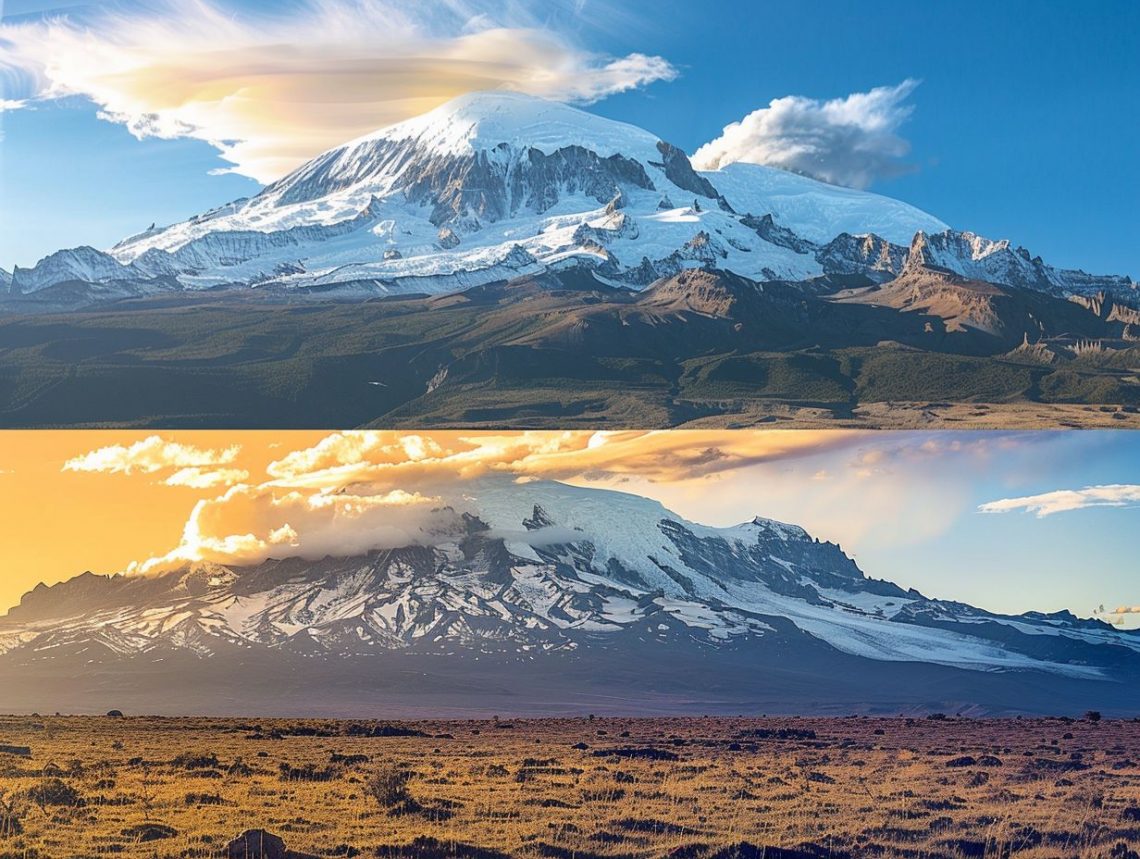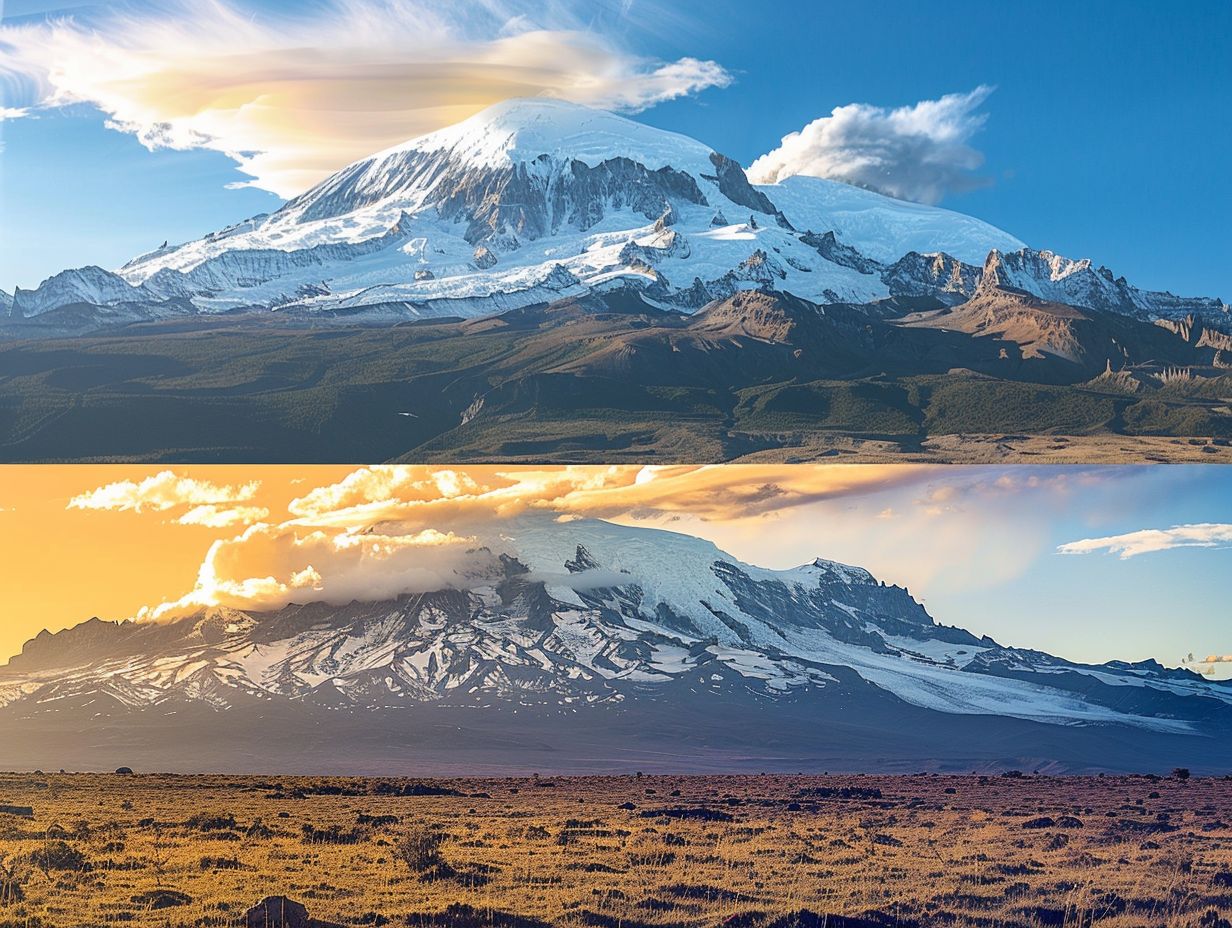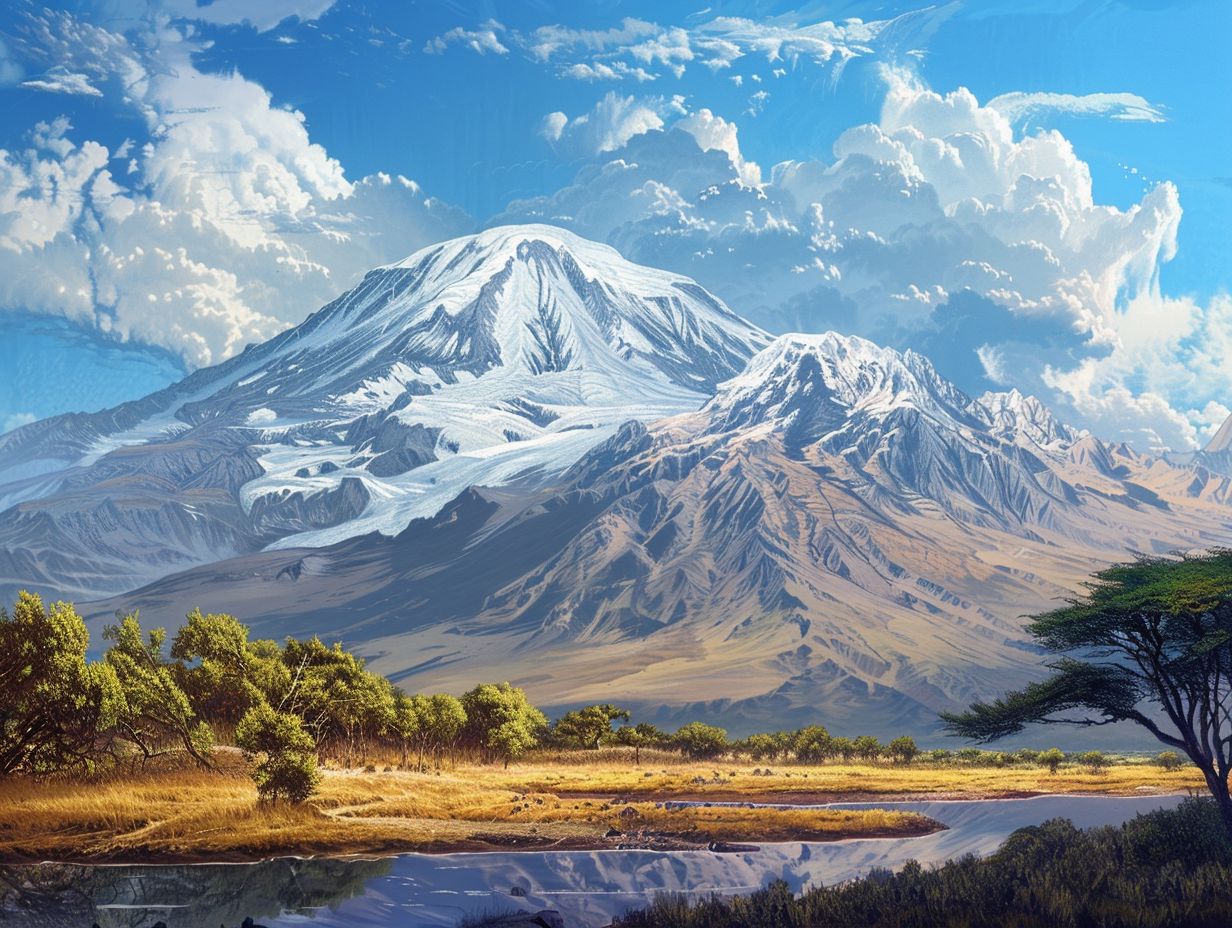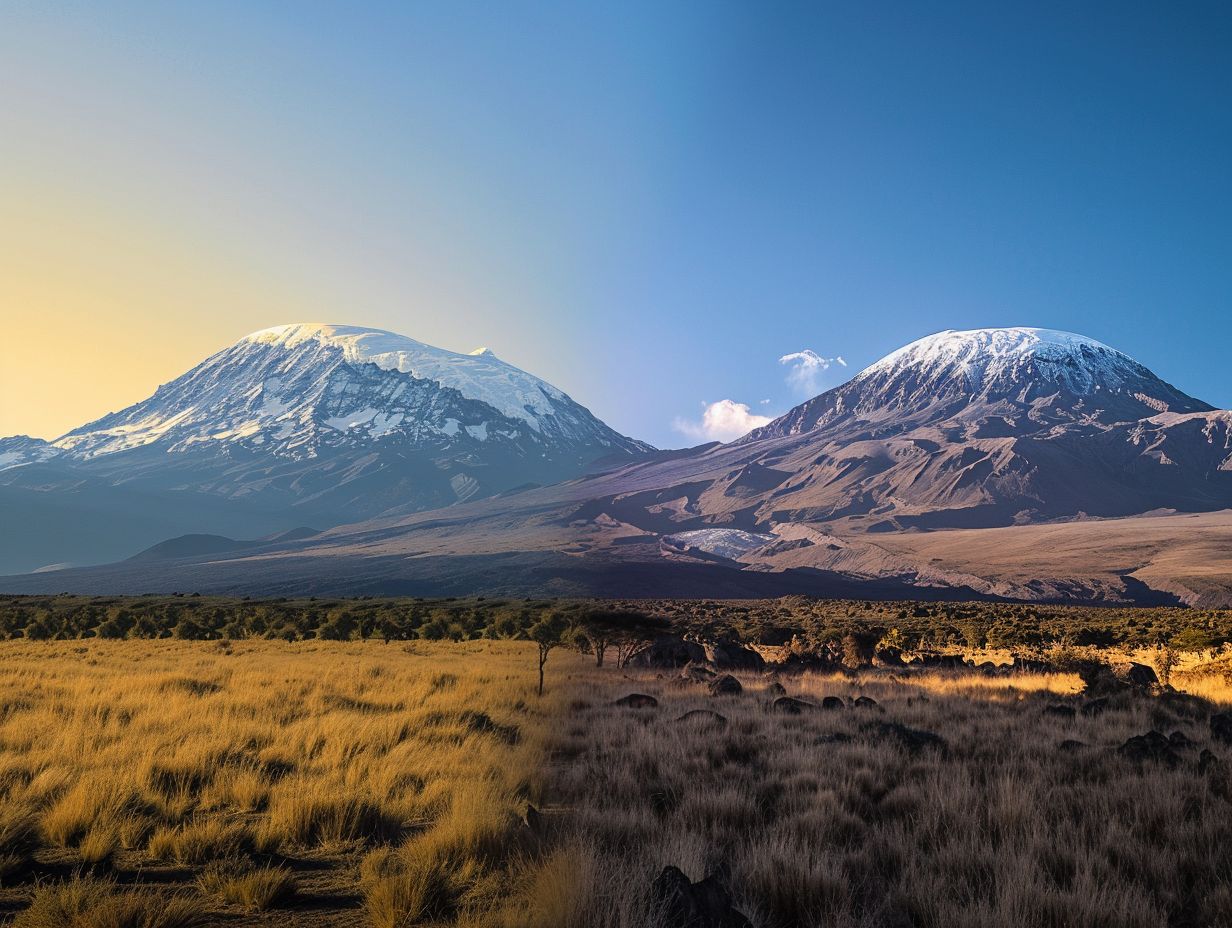
Kilimanjaro Vs Vinson
Curious about the differences between two of the world’s most famous peaks, Kilimanjaro and Vinson?
In this article, we explore their geographical location and height, the climbing difficulty of each, the best times to climb, the cost of the expeditions, and their unique features and attractions.
Whether you’re a seasoned mountaineer or just an armchair adventurer, join us as we compare and contrast these iconic mountains to help you plan your next adventure.
Key Takeaways:

- Kilimanjaro is located in Tanzania, Africa and stands at 19,341 feet, while Vinson is located in Antarctica and stands at 16,050 feet.
- Kilimanjaro is considered a moderate difficulty climb, while Vinson is extremely difficult due to harsh weather conditions and technical challenges.
- The best time to climb Kilimanjaro is during the dry seasons of January-March and June-October, while the best time for Vinson is during the summer months of November-January.
Geographical Location and Height
Mountains are majestic natural formations that soar into the sky, and among them are the world-renowned Seven Summits.
These summits include Mount Everest, Kilimanjaro, and Vinson, each located on different continents and tectonic plates.
Kilimanjaro, situated in Tanzania, Africa, stands tall as the highest peak on the African continent, reaching an awe-inspiring height of approximately 19,341 feet above sea level.
This dormant stratovolcano is a distinctive feature of the East African Rift system, offering climbers breathtaking views of it’s three volcanic cones – Kibo, Mawenzi, and Shira.
Vinson Massif, on the other hand, is nestled within the remote, icy wilderness of Antarctica, making it the most inaccessible of the Seven Summits.
Rising to a formidable elevation of around 16,050 feet, Vinson is the highest peak in Antarctica and is part of the Sentinel Range in the Ellsworth Mountains.
Where is Kilimanjaro located?
Kilimanjaro, the highest peak in Africa, is located in Tanzania, a country known for its diverse wildlife and stunning landscapes.
Located near the border of Tanzania and Kenya, Mount Kilimanjaro is a dormant volcano that stands majestically in the Kilimanjaro National Park.
It’s peak, Uhuru Peak, rises to an impressive 19,341 feet above sea level. This iconic mountain is the tallest in Africa and the highest free-standing mountain in the world.
Where is Vinson located?
Vinson, the highest peak in Antarctica, is located on this southern continent, specifically within the Vinson Massif, a range known for its icy beauty and challenging terrain.
Situated in the remote Sentinel Range of the Ellsworth Mountains, Mount Vinson stands tall at 16,050 feet (4,892 meters) above sea level.
It’s isolated location, combined with its impressive elevation, contributes to the raw and untouched appeal of this majestic peak.
The icy slopes and frigid temperatures present a formidable challenge to even the most experienced climbers, making it a sought-after destination for those seeking a true test.
Mount Vinson’s unique position as the highest point in Antarctica adds to its allure, drawing adventurers from around the globe to conquer its icy summit.
What is the height of Kilimanjaro?
The height of Kilimanjaro’s summit reaches approximately 5,895 meters above sea level, making it a prominent peak that challenges climbers.
At this towering height, climbers face various challenges due to the lower oxygen levels, extreme weather conditions, and rapid changes in temperature.
Acute mountain sickness, also known as altitude sickness, becomes a concern as the body adjusts to the decreased oxygen levels.
Despite these hurdles, reaching the summit is a rewarding experience, offering breathtaking panoramic views that extend across the expansive African plains.
The summit of Kilimanjaro is characterized by its snow-capped peaks, contrasting with the African savanna below, creating a unique and stunning visual spectacle.
The ice caps at the summit are remarkable features that have been shrinking in recent years, adding an element of urgency for climbers to witness this natural wonder.
What is the height of Vinson?
Vinson rises to an impressive altitude of approximately 4,892 meters above sea level, presenting climbers with a formidable ascent on the icy slopes of this Antarctic peak.
The extreme altitude significantly reduces oxygen levels, causing climbers to experience symptoms of altitude sickness, including fatigue, headaches, and nausea.
The harsh climate amplifies these difficulties, with freezing temperatures often plummeting to -40 degrees Celsius.
The peak’s location in the remote Antarctic wilderness adds another layer of challenge, requiring climbers to be entirely self-sufficient during their expedition.
Climbing Difficulty
Climbing the Seven Summits, including Kilimanjaro and Vinson, presents a significant challenge that tests the physical endurance and technical skills of climbers as they ascend to the summit.
What is the Difficulty Level of Climbing Kilimanjaro?

Climbing Kilimanjaro requires a blend of physical endurance, mental resilience, and acclimatization to combat the effects of altitude sickness.
Altitude sickness, also known as acute mountain sickness (AMS), poses a significant challenge for climbers due to the rapid ascent to high altitudes.
The reduced air pressure at higher elevations leads to lower oxygen levels, causing symptoms like headaches, nausea, and fatigue.
To mitigate these risks, climbers have to follow proper acclimatization strategies, such as gradual altitude gain, staying hydrated, and listening to their bodies.
This process demands patience and self-awareness, as pushing too hard too quickly can result in severe AMS.
What is the Difficulty Level of Climbing Vinson?
The ascent of Vinson poses a formidable challenge due to its technical requirements, extreme climate conditions, and logistical demands, making it a demanding climb.
Climbing Mount Vinson requires a high level of technical proficiency in ice climbing and glacier travel.
The route to the summit involves navigating crevasses, steep slopes, and icy terrain, demanding careful footwork and solid rope skills.
Along with technical skills, climbers must also withstand the harsh Antarctic weather, with temperatures dropping to -40°C or lower and strong winds posing a constant threat.
Adequate gear, including specialized cold-weather clothing and equipment, is essential for survival in such extreme conditions.
Logistical preparations for a successful ascent of Mount Vinson are complex and meticulous.
Organizing transportation to Antarctica, arranging permits, and coordinating supplies and support staff all require precise planning and coordination.
Base camps must be established at strategic points along the route to provide shelter, food, and medical assistance for climbers.
Acclimatizing to the high altitude and thin air is crucial for avoiding altitude sickness and ensuring a safe climb.
What are the Factors that Affect Climbing Difficulty?
Several factors influence the difficulty of climbing peaks like Kilimanjaro and Vinson, including altitude, weather conditions, the level of acclimatization, and the overall logistics of the expedition.
As climbers ascend higher altitudes, the air becomes thinner, leading to decreased oxygen levels and potentially causing altitude sickness.
Weather on these mountains can be extremely unpredictable, with sudden storms, high winds, and sub-zero temperatures posing significant challenges.
Proper expedition planning is crucial, involving equipment preparation, route strategizing, and contingency plans in case of emergencies.
Achieving proper acclimatization by slowly adapting to the increasing altitude can help prevent altitude sickness and improve overall climbing success rates.
Best Time to Climb
Choosing the best time to climb mountains like Kilimanjaro and Vinson is crucial, as weather conditions and summit day play a significant role.
For climbing Mount Kilimanjaro, the best times are typically during the two dry seasons: January to March and June to October.
Your chances of clear skies and good visibility are higher during these periods, making the trek more enjoyable and safer.
On the other hand, for Mount Vinson in Antarctica, the window for climbing is limited to the austral summer, from November to January.
This is when the temperature is relatively mild, and the days are longer, allowing for better acclimatization and more comfortable climbing conditions.
What is the Best Time to Climb Kilimanjaro?
The best time to climb Kilimanjaro is during the dry seasons, typically from July to September and January to February when the weather is more stable.
During these periods, climbers can benefit from clearer skies, reduced rainfall, and less risk of slippery trails, enhancing the overall safety of the ascent.
The stable weather conditions not only provide a more enjoyable experience but also increase the likelihood of successful summit attempts.
The dry seasons offer stunning panoramic views of the surrounding landscapes, making the trek even more rewarding.
Climbers can witness breathtaking sunrises and sunsets amidst the unique flora and fauna along the route.
What is the Best Time to Climb Vinson?
The optimal time to climb Vinson is during the Antarctic summer, typically from November to January, when milder weather and more manageable logistical aspects prevail.
During this period, the extended daylight hours provide climbers with ample visibility and flexibility for ascending and descending the peak.
Planning expeditions during the Antarctic summer is vital, involving acclimatization, gear preparation, and logistics for transportation and accommodation.
When weather conditions are favorable, climbers can experience clearer skies, lower wind speeds, and more stable conditions, enhancing safety and enjoyment.
What are the Weather Conditions during these Times?
During the optimal climbing seasons for Kilimanjaro and Vinson, the weather usually offers stable temperatures, minimal precipitation, and clear skies, providing favorable conditions for climbers.
For Mount Kilimanjaro, the optimal climbing period is during the dry seasons of January to February and June to October.
Temperatures at the lower levels range from 77°F to 86°F (25°C to 30°C), but as you ascend, they drop to as low as 14°F to 23°F (-10°C to -5°C) at the summit.
There is minimal rainfall during these times, enhancing visibility and reducing the risk of slippery paths.
Contrastingly, during the summer months, heavy rains increase the chances of muddy terrain and obstructed views, making the climb more treacherous.
Cost of Climbing

The various costs are influenced by factors such as logistical requirements, equipment, guides, permits, and accommodation.
When planning a trek up these iconic peaks, it’s crucial to consider the financial breakdown to ensure a successful and enjoyable experience.
The cost breakdown typically includes expenses for guides, permits, specialized equipment like high-altitude gear and climbing tools, and accommodation.
The investment needed varies depending on the route chosen and the duration of the expedition.
Mount Kilimanjaro offers several routes of varying difficulty and length, each with its own cost implications.
On the other hand, Vinson in Antarctica presents a unique set of challenges due to its remote location and extreme weather conditions.
What is the Cost of Climbing Kilimanjaro?
The cost of climbing Kilimanjaro varies depending on factors like expedition duration, permit fees, guide services, equipment rentals or purchases, and accommodation.
When embarking on this adventure, it’s crucial to consider the breakdown of costs to properly budget for the journey. Let’s delve into these components:
- Permit fees: the biggest expense, including entry and camping fees, averaging around $1000.
- Guide services: essential for safety, professional guides can cost between $1500-$2000.
- Equipment: whether renting or buying, expect to spend $300-$600 on gear like boots, clothing, and sleeping bags.
- Accommodation: opting for basic or luxury accommodations impacts overall costs significantly.
What is the Cost of Climbing Vinson?
The cost of climbing Vinson involves significant expenses due to the logistical challenges, requiring specialized gear, permits, transportation, and support services.
Specialized gear for climbing Vinson is a crucial aspect of the financial outlay, as the extreme weather conditions demand top-quality equipment.
Climbers need to factor in permit fees, which are essential for regulating the number of mountaineers in the region and ensuring safety protocols are followed.
Logistical arrangements are another key cost, encompassing everything from accommodations in Antarctica to transportation to and from the base camp.
These costs can escalate due to the remote location of Mount Vinson, necessitating charter flights and specialized logistics to access the mountain.
Taken together, the unique expenses associated with climbing Vinson make it a significant financial commitment for those seeking to conquer this challenging peak.
What are the Factors that Affect the Cost of Climbing?
During Kilimanjaro and Vinson’s prime climbing seasons, expect stable temperatures, low precipitation, and clear skies, ideal for climbers.
Logistical demands play a crucial role in determining the overall costs of these expeditions. Transport, permits, and support staff all add up to the budget.
For accommodation, trekkers can opt for anything from basic camping to luxurious lodges, each impacting the final expense differently.
Equipment considerations, including quality and rental versus purchase, can significantly affect the total cost.
Guide services, which range from basic assistance to full expedition planning, are another key component in budgeting.
Additional amenities like food, medical services, and emergency evacuation plans must also be factored in for a comprehensive financial plan.
Unique Features and Attractions
Exploring Kilimanjaro and Vinson reveals breathtaking landscapes, diverse ecosystems, and challenging terrain, enriching the climbing experience.
Mount Kilimanjaro, the highest peak in Africa, boasts its distinct appeal with a snow-capped summit, the majestic Uhuru Peak.
The route to the top takes climbers through various ecological zones, from dense rainforests to alpine deserts, providing a diverse and ever-changing backdrop.
On the other hand, Mount Vinson, located in Antarctica, appeals to those seeking a true remote adventure.
The pristine beauty of the white continent surrounds Vinson, offering a unique experience of vast snowfields and isolation that few other mountains can provide.
What are the Unique Features of Kilimanjaro?
Kilimanjaro boasts unique features such as the iconic Uhuru Peak, multiple volcanic cones, spectacular glaciers, and a rich biodiversity that showcases the diverse ecosystems.
Uhuru Peak, the highest point on Kilimanjaro, offers unparalleled panoramic views of the surrounding landscapes blending savannah and desert regions.
The volcanic cones, namely Kibo, Mawenzi, and Shira, contribute to the mountain’s distinct appearance, each with its own character and geological history.
The glaciers on Kilimanjaro, such as the diminishing Furtwängler Glacier, provide a stark reminder of the effects of climate change on these majestic ice formations.
What are the Unique Features of Vinson?
Vinson’s unique features include awe-inspiring Antarctic scenery, vast ice fields, and challenging peaks like Mount Shinn, creating a surreal environment for climbers.
Mount Vinson, standing at 16,077 feet above sea level, is the highest peak in Antarctica and one of the renowned Seven Summits challenging climbers worldwide.
The rugged icy terrains and steep slopes demand exceptional mountaineering skills, making it a coveted conquest for experienced adventurers.
The Ellsworth Mountains encapsulate this majestic peak, adding to the grandeur of the surrounding landscape.
As climbers navigate through crevasses and seracs, they are greeted by breathtaking panoramic views of the icy wilderness, a sight that is both intimidating and captivating.
What are the Main Attractions of Kilimanjaro?

The main attractions of Kilimanjaro include the stunning Shira Plateau, challenging Barranco Wall, scenic Lemosho Route, and the overall thrill of conquering.
Adventurers are captivated by the raw beauty of the vast Shira Plateau, where the altitude and rugged terrain offer a unique challenge.
The Barranco Wall, known for its steep ascent and breathtaking views, tests climbers’ skills and determination.
The tranquil Lemosho Route, winding through diverse landscapes, provides a picturesque journey to the summit.
The allure of standing on Uhuru Peak, gazing at the vast African plains below, is an unforgettable experience that energizes climbers throughout their journey.
What are the Main Attractions of Vinson?
Vinson’s main attractions encompass sights like Mount Shinn, the Branscomb Glacier, encounters with Antarctic wildlife, and the beauty of the pristine polar environment.
Ascending Mount Vinson not only offers the thrill of conquering the highest peak in Antarctica but also provides breathtaking views of the surrounding icy peaks.
The Branscomb Glacier, winding gracefully below, captivates with its azure hues contrasting against the stark white landscape.
As climbers traverse through this frozen wilderness, they may have the enchanting opportunity to witness penguins waddling nearby or seals basking on ice floes.
Frequently Asked Questions
1. What are the main differences between Kilimanjaro and Vinson?
A: Kilimanjaro and Vinson are two popular peaks for mountaineering, but they have many differences. Kilimanjaro, located in Tanzania, is the highest peak in Africa, while Vinson, located in Antarctica, is the highest peak in Antarctica. Kilimanjaro is a non-technical climb, while Vinson requires advanced mountaineering skills. Additionally, Kilimanjaro can be climbed year-round, while Vinson has a limited climbing season due to extreme weather conditions.
2. Which peak is more challenging to climb, Kilimanjaro or Vinson?
A: While both Kilimanjaro and Vinson are challenging peaks to climb, Vinson is considered to be the more difficult climb. With harsh weather conditions and technical mountaineering skills required, Vinson offers a more challenging and adventurous experience for climbers.
3. How long does it take to climb Kilimanjaro vs Vinson?
A: The time it takes to climb Kilimanjaro or Vinson depends on the route chosen and the climber’s physical fitness. On average, it takes about 7-8 days to climb Kilimanjaro, while it takes 12-14 days to climb Vinson. However, some experienced climbers have completed both peaks in a shorter amount of time.
4. Which peak offers a better view, Kilimanjaro or Vinson?
A: Both Kilimanjaro and Vinson offer stunning views, but they are vastly different. Kilimanjaro is known for its breathtaking views of the African savannah, while Vinson offers a rugged and isolated view of the Antarctic landscape. Both views are unique and worth the climb.
5. What kind of equipment is needed to climb Kilimanjaro vs Vinson?
A: Due to the varying terrain and weather conditions, different types of equipment are needed for Kilimanjaro and Vinson. For Kilimanjaro, basic hiking gear and warm clothing are necessary, while Vinson requires specialized mountaineering equipment such as crampons, ice axes, and high-altitude gear. It is essential to consult with a guide or experienced climber to ensure you have the proper equipment for the climb.
6. Can I climb both Kilimanjaro and Vinson in one trip?
A: While it is physically possible to climb both Kilimanjaro and Vinson in one trip, it is not a common practice. The two peaks are located in vastly different locations, and the logistics and costs of doing both climbs in one trip would be challenging. It is recommended to plan separate trips for each peak to fully experience and appreciate each climb.